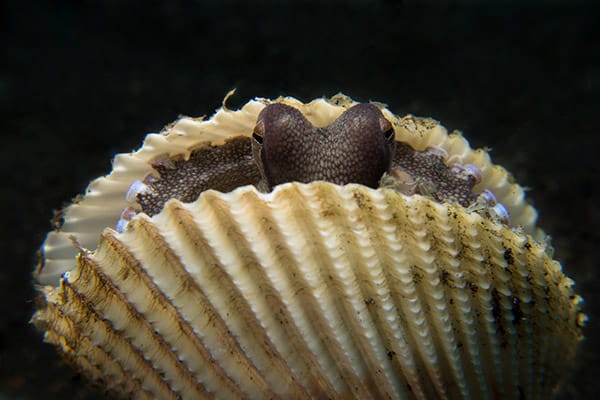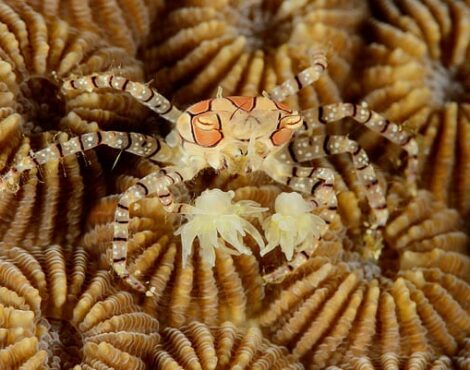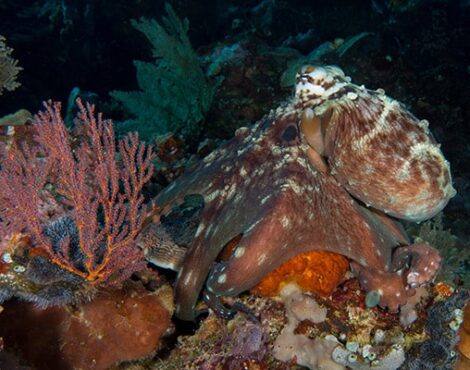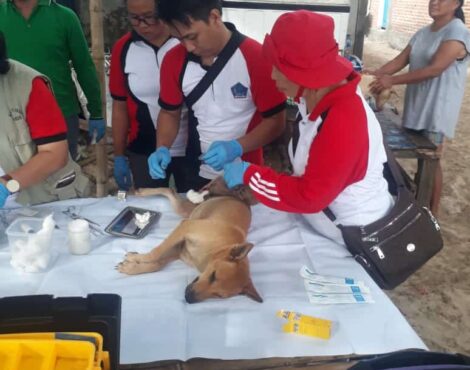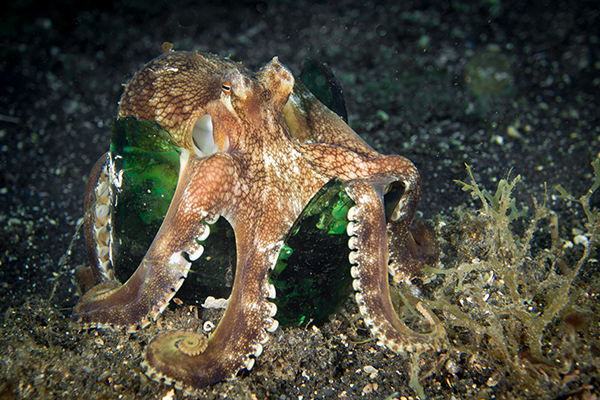
The sandy slopes of North Sulawesi are world famous for the bizarre creatures that inhabit them.
From terrifying giant predatory worms, to psychedelic coloured nudibranch and frogfish the size of your smallest fingernail, the muck diving in Bunaken Marine Park has everything you could possibly want, and more.
One of the most interesting aspects of muck diving is seeing all the weird and wonderful ways that the animals have evolved to survive in a relatively inhospitable environment. Some critters bury themselves into the substrate, waiting for any potential prey to pass by before pouncing. Others have evolved to take the form of sea grass, hydroids, sponges, or other inanimate marine objects.
And then there is the coconut octopus, whose unique survival strategy gives it the prestigious status of the oceans most resourceful animal, and one of the worlds most intelligent invertebrates.
What is a Coconut Octopus? or Veined Octopus?
Native to the western Pacific Ocean, the Amphioctopus marginatus is an octopus species that is more commonly known as the âcoconut octopusâ or the âveined octopusâ. With a body that grows to an average of 8 centimetres long and arms that average 15 centimetres, the coconut octopus can be described as medium-sized.
Like all other octopus, the coconut octopus can alter its colouration to help it blend in with its surroundings, however their normal colour is a reddy-browny body, mottled with dark lines that resemble veins â hence the name âveined octopusâ -, a yellow siphon, and extremely conspicuous white suctions pads.
Another way they are easy to recognise is from the skirt (webbing) between the arms, which goes much further towards the tips of the arms than most other octopus. This gives the coconut octopus almost a parachute like appearance.
Why âCoconut Octopusâ?
Back in 2009, a couple of marine biologists from Melbourne travelled to North Sulawesi and Bali to conduct research on veined octopus (the common term back then). They spent over 500 hours observing the octopus, and they discovered something very interestingâ¦
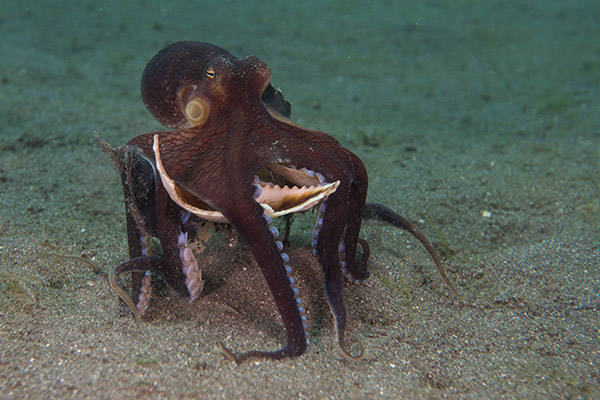
The octopus would pick up, and carry around empty coconut shells to use as a mobile home. Before this was seen, it was known that veined octopus would live inside empty shells, as many other octopus do, but this was the first time they had been scientifically recorded moving around with them.
It wasnât just one smart individual either. They observed over 20 different veined octopus perform the exact same behaviour.
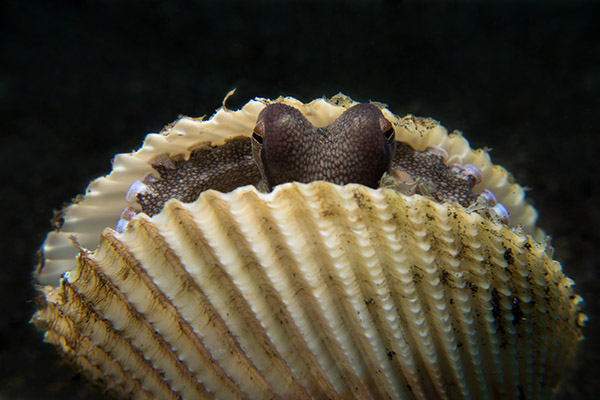
It isnât as easy as just picking shells up either. Many times the octopus would have to dig the shell out of the sand, clean it off with carefully aimed water jets, before manoeuvring them into position. They also noted that it wasn’t just coconut shells either. The octopus would prefer the coconut shells, but if they werenât available, they would instead opt for empty clam shells, however they also noticed they were very picky about which shells they would take.
Since then, the more common name of âcoconut octopusâ was adopted, and we think it is far more appropriate, donât you?
How do Coconut Octopus Move?Â
As you can probably imagine, it isnât easy for a small octopus to walk around the seabed while carrying two half shells that are bigger than itself.
The two marine biologists who were studying them at the time noticed that the octopus were almost sitting on the shells and supporting them with two arms on either side. They would use the rest of their arms to drag themselves across the seabed. This style of locomotion was later named as âStilt Walkingâ.
It may not look to be the most effective way of moving around, however, they can pull the shells shut at a moments notice, giving themselves access to an instant fortress. Although some predators would possibly be strong enough to crack open their portable lair, most of them would not have the intelligence to do so. The coconut octopus was the first invertebrate to be recorded using tools, and they are still one of only a handful of sea creatures that have learnt tool use.
Coconut Octopus Interactions.Â
Only those who have every dived with these fascinating little octopus will know just how fascinating they really are.
Like many other octopus, they are very inquisitive, however the coconut octopus take the word inquisitive to another level.
They are known to jump onto divers, feeling the equipment and seeing if there is anything useful for them to take. There are numerous videos online of divers setting up GoPro action cams to get close up footage, only to have the camera pulled into the coconut octopuses lair. This usually results in the diver having to play a game of tug of war to get the camera back. If offered a shell by divers, they will take it into their lair, test it, and if they donât like it, they will throw it out. If they do like it, they will keep it, and often will throw out an older one that is not as good as the new one.
Although they seem to be happy to interact with divers, the standard rules still apply and you should still never attempt to handle them. If they jump onto you, just remain where you are and it will soon get bored with you and let go.
What do Coconut Octopus Eat?Â
Just like most other octopus species, the coconut octopus lives off a diet that includes invertebrates such as shrimp, crabs and clams, although it will also eat small fish if it can catch them.
Their favourite times of day for hunting is dusk and dawn, and they feed by either grabbing their prey with their arms or smothering it with their skirt (the webbed areas between their arms). Just like all other octopus species, the coconut octopus has a venomous bite, and one bite will quickly paralyse its prey. They can also use their beak to drill into hard shells like clams, and inject their venom before sucking the paralysed animal out of the drill hole.
Although they are venomous, the venom poses no threat to humans, unlike their more (unfairly) infamous relative, the âblue ringed octopusâ.
Where can I Dive with a Coconut Octopus?Â
Just like most other marine creatures, coconut octopus are seasonal, however, the seasons are random. During some times of the year we will see them every other day, while at other times we may go for weeks or months without seeing one.
Because they like sandy environments, the best place to find them is on the North Sulawesi mainland while muck diving.
Although they are not nocturnal, we seem to have better luck finding them at night, so your best bet would be to join one of our popular muck diving night dives. Even if we donât find one, you have a very good chance of spotting other incredible cephalopods such as pygmy cuttlefish, long armed octopus, and the bobtail squid.
Photographing Coconut Octopus.Â
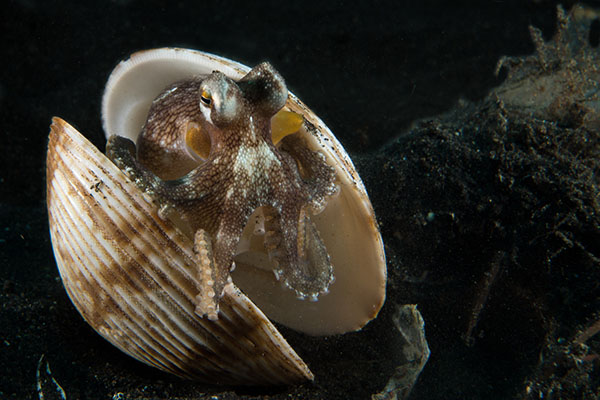
Because coconut octopus are very inquisitive, they are fairly easy to photograph, often sticking around in one spot for an extended period of time. They also make very good subjects for behavioural photography as they are almost always holding a shell, and if they arenât you can probably bet that they are looking for one.
Despite the fact it sticks around while you are busy taking pictures, you should still follow the basic rules of photography etiquette, and not take too many shots with a high powered flash. They will still get stressed out if you keep flashing them, and too much light exposure could temporarily stun them, leaving them open to predation.

